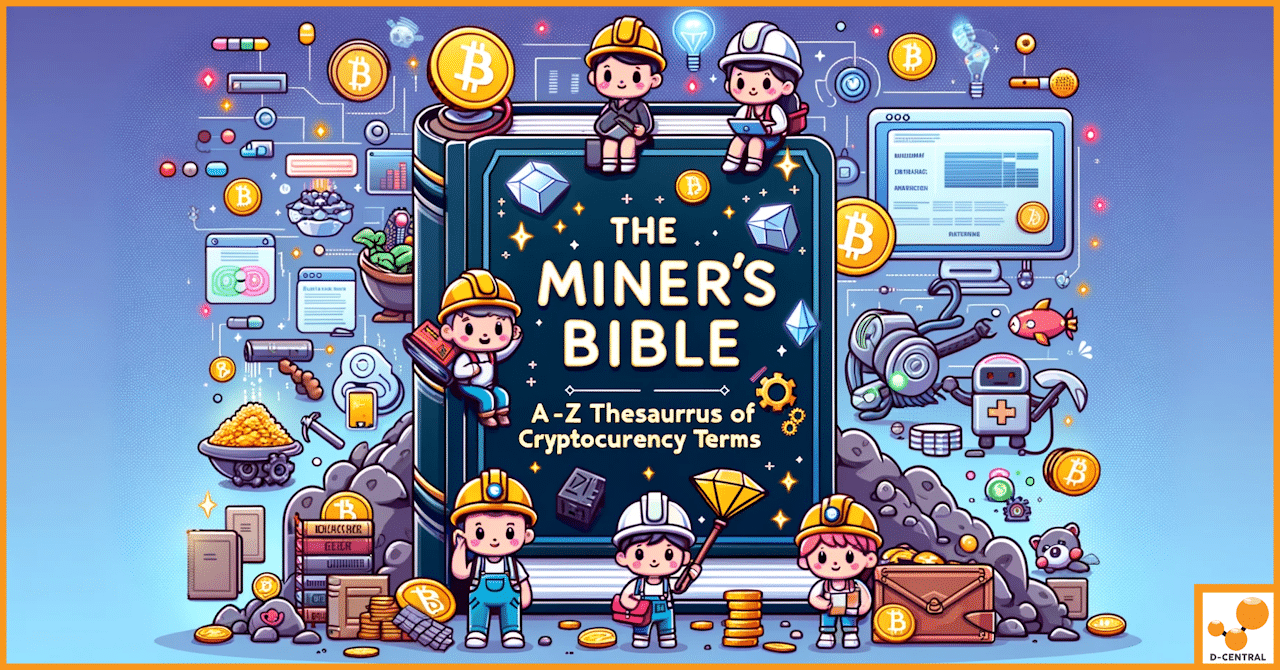
Transform Your Antminer S19 Series: Upgrading to Liquid Cooling with the Hydro Heatsink Kit
Bitcoin mining, a process that secures the Bitcoin network and processes transactions, is a power-intensive operation. The high-performance hardware used
4479 Desserte Nord Autoroute 440, Laval, QC H7P 6E2

Cryptocurrency mining has rapidly evolved from a niche hobby to a complex and significant industry, integral to the functioning of the digital currency ecosystem. Understanding the terminology associated with cryptocurrency mining is not just beneficial; it’s essential for anyone looking to engage with this dynamic field, whether as a hobbyist, investor, or professional miner. The lexicon of cryptocurrency mining is rich and varied, encompassing a wide range of concepts from the technical intricacies of blockchain technology to the strategic nuances of mining operations.
At the forefront of this evolving landscape is D-Central Technologies, a trailblazer in the Bitcoin mining industry. Founded with a deep-rooted belief in Bitcoin Maximalism and a commitment to the Cypherpunk ethos, D-Central Technologies has established itself as Canada’s premier ASIC repair center and a trusted authority in the realm of cryptocurrency mining. Our expertise is not limited to just repairing and maintaining mining equipment; we are also renowned for our comprehensive mining support, hosting solutions, and our innovative approach to optimizing mining efficiency and sustainability.
D-Central Technologies’ journey began with a clear vision: to empower individuals and organizations in the cryptocurrency mining space by providing top-notch services, reliable information, and cutting-edge solutions. As the industry has grown, so has our resolve to stay at the forefront, continually adapting and expanding our services to meet the ever-changing needs of our clients. From individuals starting with a single ASIC miner to large-scale operations seeking efficient hosting solutions, our diverse range of services caters to all levels of mining enthusiasts.
Our commitment to education and empowerment is reflected in our efforts to demystify the complex world of cryptocurrency mining. This comprehensive thesaurus is a testament to that commitment, designed to provide clarity and insight into the often intricate jargon of the mining world. Whether you are a seasoned miner or just starting, this guide will serve as an invaluable resource, helping you navigate the technicalities and strategies of cryptocurrency mining with confidence.
As we delve into this thesaurus, remember that each term is a gateway to deeper understanding and more effective participation in the world of cryptocurrency mining. With D-Central Technologies by your side, you’re not just learning about mining; you’re becoming part of a community that’s at the cutting edge of digital currency innovation.
Cryptocurrency represents a revolutionary type of digital or virtual currency that utilizes cryptography for security. Unlike traditional currencies, it operates independently of a central authority, such as a government or central bank, making it decentralized. This decentralization not only challenges the conventional monetary system but also introduces a new era of financial freedom and inclusivity. Cryptocurrencies like Bitcoin, championed by D-Central Technologies, have paved the way for a myriad of other digital currencies, each with unique features and purposes, fundamentally altering our perception and interaction with money.
At the heart of every cryptocurrency is blockchain technology, a digital ledger that records all transactions across a network of computers. This technology ensures transparency, security, and immutability of data, making it nearly impossible to alter transaction histories. Each ‘block’ in the chain contains a number of transactions, and every time a new transaction occurs on the blockchain, a record of that transaction is added to every participant’s ledger. This decentralized and distributed nature of blockchain is what gives cryptocurrencies like Bitcoin their power and reliability.
A mining rig is a specialized computer system used for mining cryptocurrencies. It typically consists of multiple high-performance graphics processing units (GPUs) or more specialized equipment like ASICs (Application-Specific Integrated Circuits), which D-Central Technologies expertly repairs and maintains. These rigs are designed to solve complex mathematical problems that validate and process transactions on the blockchain. The efficiency, cost, and power consumption of a mining rig can significantly impact the profitability of cryptocurrency mining operations.
Hash rate is a critical concept in cryptocurrency mining, referring to the speed at which a mining rig can perform the complex calculations required to validate transactions on the blockchain. Measured in hashes per second (H/s), a higher hash rate increases a miner’s chances of solving the mathematical problem, validating a transaction, and hence, earning cryptocurrency. D-Central Technologies provides solutions that optimize hash rates, ensuring that miners can achieve the best possible performance from their rigs.
Mining pools are groups of miners who combine their computational resources over a network to increase their chances of successfully mining a block and receiving rewards. By joining a mining pool, individual miners can work together to achieve a higher combined hash rate, significantly increasing their chances of validating transactions and earning rewards. Rewards are then distributed among pool members proportionally to the amount of computational power each contributed. This collaborative approach democratizes mining, making it more accessible and profitable for individual miners with less powerful rigs.
An Application-Specific Integrated Circuit (ASIC) is a type of hardware specifically designed for cryptocurrency mining. Unlike general-purpose hardware like CPUs or GPUs, ASICs are tailored for efficiently solving the cryptographic puzzles required in mining specific cryptocurrencies, such as Bitcoin. These devices offer a significant advantage in terms of speed and energy efficiency compared to other types of mining hardware. At D-Central Technologies, we specialize in the repair and maintenance of ASICs, ensuring that miners can maximize their mining operations’ efficiency and profitability.
Proof of Work (PoW) is the original consensus algorithm used in a blockchain network to confirm transactions and add new blocks to the chain. This mechanism requires miners to solve complex mathematical problems, with the first miner to solve the problem being rewarded with the cryptocurrency. PoW ensures network security and integrity but is often criticized for its high energy consumption. Bitcoin, the primary focus of D-Central Technologies, operates on this PoW mechanism, underscoring its importance in the cryptocurrency ecosystem.
Proof of Stake (PoS) is an alternative consensus mechanism that aims to address some of the energy efficiency issues associated with PoW. In PoS, the creator of a new block is chosen in a deterministic way, based on the user’s wealth, also known as the ‘stake’. Instead of miners, there are validators who lock up some of their coins as a stake in the network. Validators are then rewarded for the creation of blocks based on their stake. PoS is seen as a more energy-efficient and environmentally friendly approach to maintaining blockchain integrity.
Smart contracts are self-executing contracts with the terms of the agreement directly written into code. They run on blockchain networks and automatically execute, control, or document legally relevant events according to the terms of a contract or an agreement. Smart contracts eliminate the need for intermediaries, reducing transaction costs and increasing transaction speed. They are a fundamental component of many blockchain platforms, including Ethereum, which supports a variety of decentralized applications and services.
Decentralized Finance (DeFi) is an emerging financial technology based on secure distributed ledgers similar to those used by cryptocurrencies. DeFi aims to democratize finance by replacing traditional, centralized intermediaries with peer-to-peer relationships that can provide a full spectrum of financial services, from everyday banking, loans and mortgages, to complex contractual relationships and asset trading. DeFi operates without a central authority and uses smart contracts on blockchains, primarily Ethereum, to execute transactions. This innovation offers a more open, accessible, and equitable financial system.
Yield Farming is a popular strategy in the decentralized finance (DeFi) space, where cryptocurrency holders earn rewards by staking their digital assets in a liquidity pool. This process involves lending or staking cryptocurrencies in exchange for interest or other forms of rewards, often in the form of additional cryptocurrency. Yield farming can be a lucrative way to generate passive income from crypto holdings, but it also comes with its own set of risks, including market volatility and smart contract vulnerabilities. It’s a strategy that requires a good understanding of the DeFi ecosystem and the various protocols involved.
Liquidity Mining is closely related to yield farming but focuses specifically on providing liquidity to decentralized exchanges (DEXs). Users supply digital assets to liquidity pools, which are then used for facilitating trading on the platform. In return, they earn rewards, typically in the form of transaction fees or governance tokens. This process not only incentivizes the provision of liquidity to the platform but also helps in maintaining the overall health and efficiency of the DeFi ecosystem.
The Mining Algorithm is a set of cryptographic rules that miners must follow to validate transactions and secure the blockchain. Different cryptocurrencies use different mining algorithms, each with its own set of requirements and challenges. For example, Bitcoin uses the SHA-256 algorithm, while Ethereum initially used Ethash. The choice of algorithm impacts the mining process, including the type of hardware that can be used and the overall network security. Understanding these algorithms is crucial for miners to optimize their mining strategies and hardware configurations.
A 51% Attack is a potential security breach in a blockchain network, where an individual or group gains control of more than 50% of the network’s mining power. This majority control allows them to manipulate the network, potentially enabling them to double-spend coins, prevent new transactions from being confirmed, or even reverse transactions that were completed while they controlled the network. Such an attack undermines the trust and security of the blockchain, though it’s important to note that executing a 51% attack, especially on larger networks like Bitcoin, requires immense resources and is generally not economically viable.
Stablecoins are a type of cryptocurrency designed to offer stability in a market known for its volatility. They achieve this by being pegged to a more stable asset, like fiat currencies (e.g., USD, EUR) or commodities like gold. This pegging mechanism helps maintain a consistent value, making stablecoins an ideal choice for everyday transactions, reducing the risk for traders and investors, and serving as a safe haven during periods of high volatility in the crypto market. Examples of popular stablecoins include Tether (USDT), USD Coin (USDC), and Binance USD (BUSD).
Altcoins, or “alternative coins,” encompass all cryptocurrencies other than Bitcoin. These digital currencies offer various technological advancements, improvements, or different use cases compared to Bitcoin. Examples include Ethereum, known for its smart contract functionality; Litecoin, designed as a “lighter” version of Bitcoin with faster transactions; and Ripple (XRP), which focuses on facilitating real-time cross-border payment systems. Altcoins contribute to the diversity and innovation within the cryptocurrency ecosystem, each addressing different needs and challenges.
Tokenization is the process of converting rights to an asset into a digital token on a blockchain. This innovative approach allows for the fractional ownership of real-world assets like real estate, art, or commodities, making them more accessible to a broader range of investors. Tokenization not only democratizes access to various asset classes but also enhances liquidity, reduces transaction costs, and improves transparency. It represents a significant shift in how assets are owned, traded, and managed in the digital age.
Non-Fungible Tokens (NFTs) are unique digital assets that represent ownership or proof of authenticity of a specific item or piece of content, using blockchain technology. Unlike cryptocurrencies like Bitcoin or Ethereum, which are fungible and can be exchanged on a one-to-one basis, each NFT has a distinct value and cannot be exchanged on a like-for-like basis. NFTs have gained immense popularity in digital art, collectibles, and gaming, providing a new way for creators to monetize their work and for collectors to own digital assets with verified authenticity.
Cryptojacking is a significant security threat in the cryptocurrency world. It involves unauthorized use of someone else’s computing resources to mine cryptocurrency. Hackers implant malware that hijacks the processing power of the victim’s device, often without their knowledge, to mine cryptocurrencies. This not only slows down the affected devices but can also lead to increased energy costs and reduced lifespan of the device. Awareness and robust cybersecurity measures are essential to protect against such threats.
The environmental impact of cryptocurrency mining, particularly its substantial energy consumption, has been a topic of growing concern. Traditional mining methods, especially those relying on non-renewable energy sources, have a significant carbon footprint. The industry is increasingly seeking sustainable solutions, such as using renewable energy sources and developing more energy-efficient mining hardware. These efforts aim to make cryptocurrency mining more environmentally friendly and sustainable in the long term.
A mining farm is a large-scale cryptocurrency mining operation where numerous miners (hardware) are set up in a single location to mine cryptocurrencies. These facilities often benefit from economies of scale, achieving more efficient mining operations compared to individual miners. However, they require significant investment in hardware, infrastructure, and energy. Effective management, cooling solutions, and maintenance are crucial for the optimal operation of a mining farm.
At D-Central Technologies, we recognize the importance of energy efficiency in cryptocurrency mining. Our approach focuses on optimizing mining operations to reduce their environmental impact. This includes using energy-efficient hardware, exploring renewable energy sources, and implementing innovative techniques to maximize mining efficiency. Our commitment to sustainability is not just about reducing costs; it’s about contributing to a more environmentally responsible and sustainable future for the cryptocurrency mining industry.
Blockchain oracles play a crucial role in the broader blockchain ecosystem, especially in the context of smart contracts. They act as bridges between blockchains and the outside world, providing external data that smart contracts need to execute under specific conditions. For instance, a smart contract for a weather-related bet would require a reliable oracle to supply accurate weather data. The accuracy and reliability of these oracles are vital, as they directly impact the execution and outcomes of smart contracts.
Segregated Witness, commonly known as SegWit, is a significant protocol upgrade implemented on the Bitcoin network. Its primary purpose is to increase the block size limit on the blockchain by removing signature data from Bitcoin transactions. When certain parts of a transaction are removed, this frees up space or capacity to add more transactions to the chain. SegWit also solves the transaction malleability problem, enhancing the blockchain’s security and paving the way for further developments like the Lightning Network.
The Lightning Network is a “second layer” payment protocol that operates on top of a blockchain-based cryptocurrency like Bitcoin. It is designed to enable fast and scalable transactions among participating nodes and has been touted as a solution to the Bitcoin scalability problem. By enabling transactions to be processed more quickly and cheaply, the Lightning Network significantly increases the transaction throughput of the Bitcoin network, making it more practical for everyday transactions and microtransactions.
Atomic Swaps are a technology that enables the exchange of one cryptocurrency for another without the need for a trusted third party or centralized exchange. These swaps use smart contract technology to enable cross-chain trading directly between users, ensuring a high degree of security and decentralization. Atomic Swaps can be executed on-chain (between two blockchains) or off-chain (away from the main blockchain, as in the Lightning Network), and they are pivotal in enhancing interoperability between different cryptocurrencies.
In the realm of cryptocurrency, securing digital assets is paramount. Cold wallets and digital wallets represent two primary methods of storage, each offering different levels of security. Cold wallets, also known as hardware wallets or cold storage, are physical devices that store cryptocurrencies offline. They are immune to online hacking attempts, making them one of the most secure options for storing large amounts of cryptocurrency. Digital wallets, on the other hand, are software-based and can be either online (hot wallets) or offline. While they offer more convenience for transactions, they are generally considered less secure than cold wallets due to their connectivity to the internet. Both types of wallets play a crucial role in the security strategy of any cryptocurrency miner or investor.
In the Ethereum network, ‘Gas’ refers to the computational effort required to execute operations like transactions and smart contracts. Gas is measured in Gwei, and each operation on the Ethereum network requires a certain amount of Gas to be executed. The cost of Gas fluctuates based on network demand, making it a dynamic and sometimes significant factor in Ethereum-based transactions. Understanding and calculating Gas costs is essential for efficient transaction processing and smart contract execution in the Ethereum ecosystem.
Double spending is a potential issue in digital currency systems where the same digital token can be spent more than once. This risk is inherent due to the digital nature of cryptocurrencies, as digital information can be replicated easily. Blockchain technology addresses this challenge through its decentralized ledger and consensus mechanisms like Proof of Work (PoW) and Proof of Stake (PoS). These mechanisms ensure that once a transaction is added to the blockchain, it cannot be duplicated or reversed, thereby preventing double spending and maintaining the integrity of the transaction history.
The journey through the complex and fascinating world of cryptocurrency mining is one that is continually evolving, with new terms and technologies emerging regularly. Understanding the terminology and concepts associated with cryptocurrency mining is not just a matter of linguistic proficiency; it’s about gaining the knowledge and insight needed to navigate this dynamic field effectively. From the basics of blockchain and mining rigs to the intricacies of smart contracts and the Lightning Network, each term unlocks a deeper understanding of how digital currencies operate and are mined.
At D-Central Technologies, we recognize the importance of this knowledge for everyone involved in cryptocurrency mining, from beginners to seasoned professionals. Our commitment goes beyond providing top-tier ASIC repair services and mining solutions; we are dedicated to educating and supporting the mining community. By sharing our expertise and insights, we aim to empower miners with the information they need to make informed decisions and optimize their mining operations.
We invite you to explore the range of services and educational resources offered by D-Central Technologies. Whether you are looking to start your mining journey, seeking to enhance your existing operations, or simply curious about the world of cryptocurrency, D-Central is here to guide and support you every step of the way. Visit our website to learn more about our services, delve into our informative content, and become part of a community that’s at the forefront of the cryptocurrency mining industry.
Together, let’s navigate the ever-evolving landscape of cryptocurrency mining and harness its full potential.
What is D-Central Technologies?
D-Central Technologies is a leader in the Bitcoin mining industry in Canada, specializing in ASIC repair, maintenance, and comprehensive mining support. They are committed to empowering individuals and organizations in the cryptocurrency mining space.
What is cryptocurrency?
Cryptocurrency is a digital or virtual currency that uses cryptography for security and operates independently of a central authority. It represents a new era of financial freedom and inclusivity.
What is blockchain technology?
Blockchain technology is a digital ledger that records all transactions across a network of computers. It ensures data transparency, security, and immutability, fundamental to cryptocurrencies.
What is a mining rig?
A mining rig is a specialized computer system designed for mining cryptocurrencies. It typically includes multiple high-performance GPUs or ASICs to solve mathematical problems and validate transactions on a blockchain.
What does hash rate mean in mining?
Hashrate refers to the speed at which a mining rig performs calculations required to validate transactions on a blockchain. Measured in hashes per second, a higher hash rate improves a miner’s chances of earning cryptocurrency.
What is a mining pool?
A mining pool is a group of miners who combine their computational resources to increase their chances of mining a block and earning rewards. Rewards are distributed proportionally based on each member’s contributed computational power.
What is an ASIC in cryptocurrency mining?
An ASIC (Application-Specific Integrated Circuit) is specialized hardware designed for cryptocurrency mining, offering greater speed and energy efficiency for mining specific coins.
What are the environmental concerns related to cryptocurrency mining?
Cryptocurrency mining is known for high energy consumption and its carbon footprint. D-Central Technologies is exploring renewable energy sources and more energy-efficient mining hardware to make mining more sustainable.
What is DeFi (Decentralized Finance)?
DeFi (Decentralized Finance) is a financial technology that uses secure distributed ledgers to remove traditional centralized intermediaries, offering an open, accessible, and equitable financial system.
How can D-Central Technologies assist me in my mining endeavours?
D-Central Technologies provides a range of services tailored to mining enthusiasts of all levels, including equipment repair, hosting solutions, education, and strategies for optimizing mining efficiency.
DISCLAIMER: D-Central Technologies and its associated content, including this blog, do not serve as financial advisors or official investment advisors. The insights and opinions shared here or by any guests featured in our content are provided purely for informational and educational purposes. Such communications should not be interpreted as financial, investment, legal, tax, or any form of specific advice. We are committed to advancing the knowledge and understanding of Bitcoin and its potential impact on society. However, we urge our community to proceed with caution and informed judgment in all related endeavors.
Related Posts

Bitcoin mining, a process that secures the Bitcoin network and processes transactions, is a power-intensive operation. The high-performance hardware used

In the ever-evolving landscape of digital finance, Bitcoin mining has emerged as a crucial process that holds the fort for

In 2009, the world witnessed the birth of Bitcoin, a digital currency that promised to redefine the concept of money